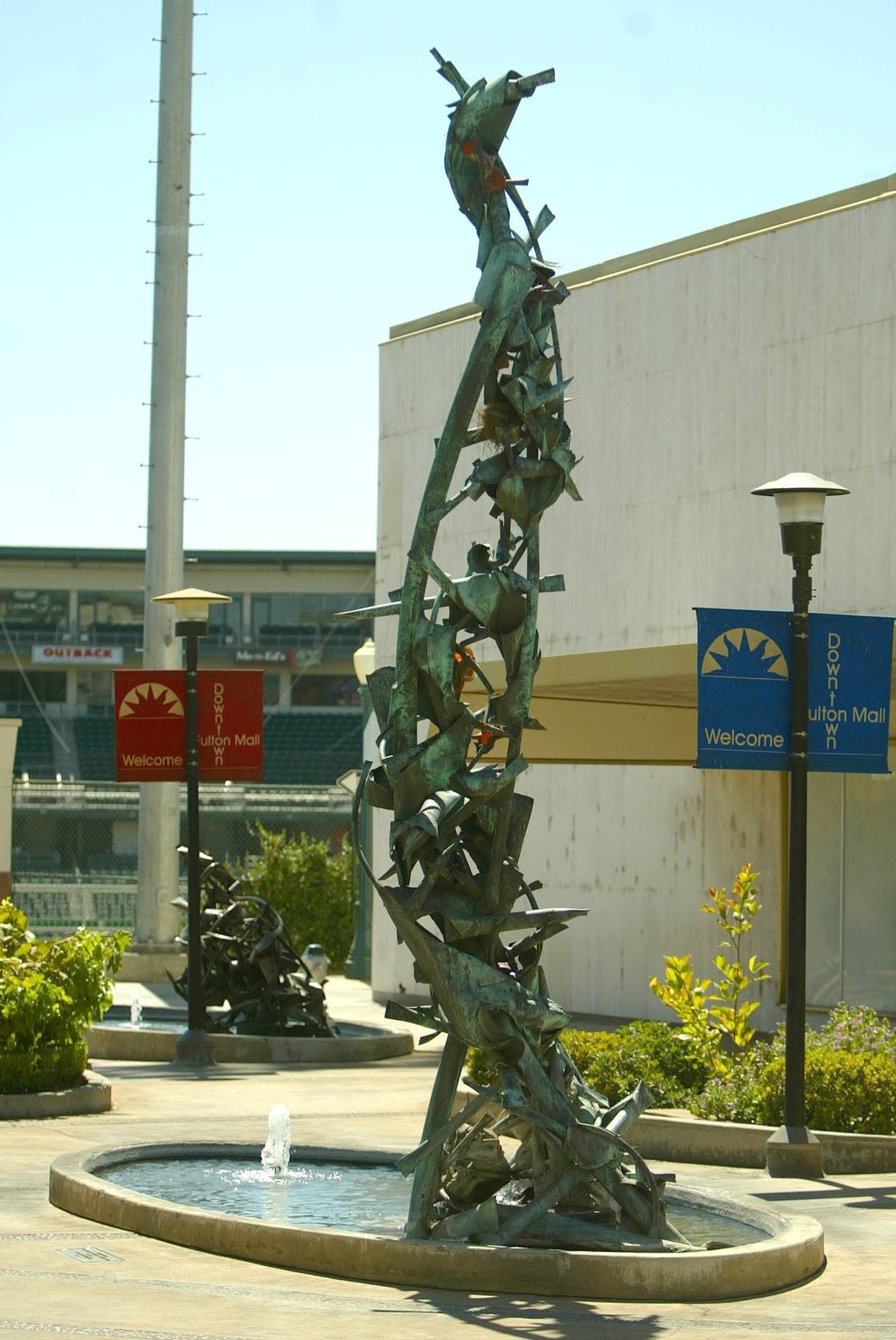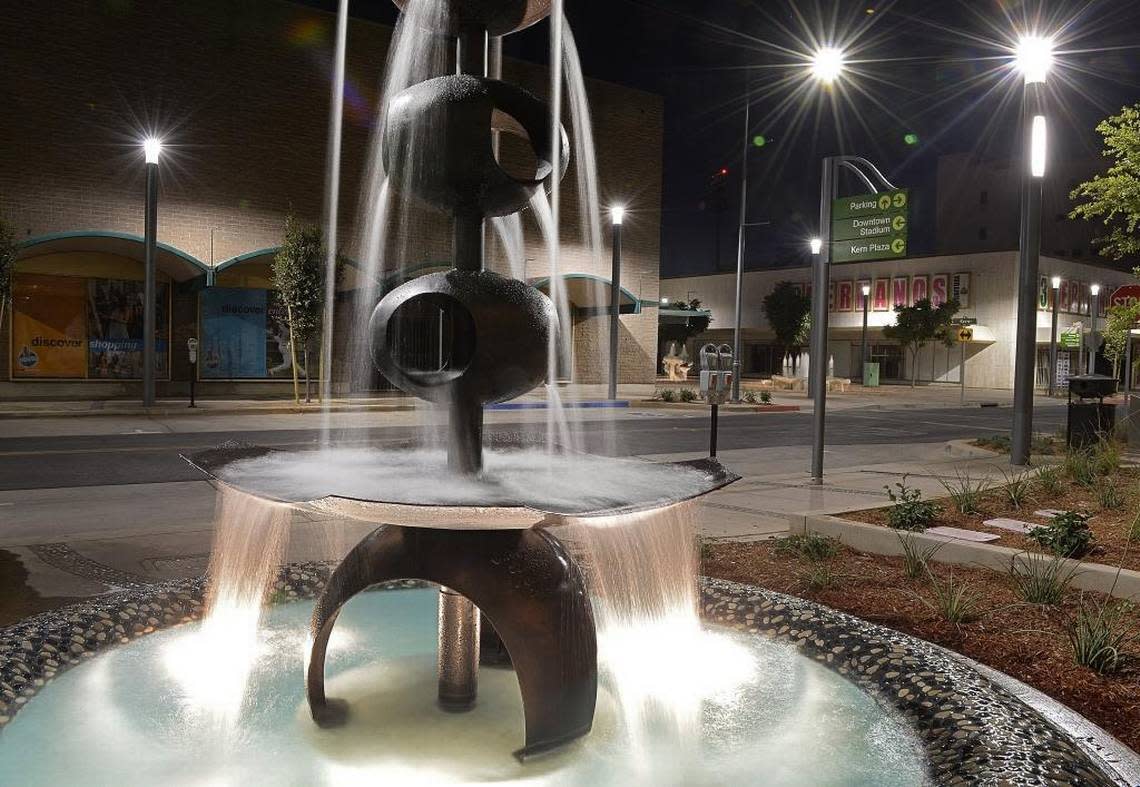Fresno took ‘cheap’ route protecting Fulton Street art. Now sculptures are mangled
When Fulton Street in downtown Fresno reopened to cars, roughly 25% of the $20 million project went toward restoring and reinstalling the city’s public art.
As a result, the sculptures and fountains that occupied the old Fulton Mall sparkled like they hadn’t in decades. Rather than hang its collective head over their neglect, Fresno could puff out its chest. In the final accounting, however, certain corners were cut that, five years later, have come back to haunt City Hall after several of the collection’s best-known works were vandalized during the pandemic.
For about a year I’ve been asking city officials about “The Three Fires,” a three-piece collection removed from the plaza outside the Kern Street entrance to Chukchansi Park. This week, in a meeting with Fresno Mayor Jerry Dyer, Fresno City Councilmember Miguel Arias and others, the complete answers finally came.
In July 2020 and March 2021, each of the three abstract depictions of fire made from copper tubing and Venetian glass by West Coast sculptor Claire Falkenstein sustained heavy damage at the hands of metal thieves and a mentally ill homeless person, according to city officials. Two of them (“Smoldering Fires” and “Spreading Fires”) are mangled so badly the late artist’s nonprofit has requested they not be repaired.
“He had torn out the glass pieces within the (sculpture) and also took his shirt and hung on the metal until it would rip,” said Heidi Briggs, the city’s senior risk analyst. “The other vandals, I believe, used a torch.”
Opinion
Then in November 2021 another piece of the Fulton Street collection (“Obos” by George Tsutakawa) got sawed in half and left on the sidewalk — apparently when the would-be thief discovered the 13-foot-tall bronze statue was too heavy to drag away.
There are no persons of interest in any of these incidents, which are thought to have occurred during the overnight hours when Fulton Street and its city-owned art collection were left unprotected by both police and private security.
Why no middle-of-the-night patrols on Fulton Street? Because the Fresno Police Department’s downtown unit only works day shifts, and private security hired by the Downtown Fresno Partnership clocks out at 11 p.m.
I kid you not.
Sad to see a Fulton Mall sculpture/fountain vandalized last night or this morning. Looks like someone was attempting to steal it. pic.twitter.com/nnkDFSV2xP
— Kiel Lopez-Schmidt (@kieltls) November 19, 2021
‘We tried to do things on the cheap’
Fulton Street’s restored sculptures and fountains were also left vulnerable by decisions made by city officials during the October 2017 reopening. Going against recommendations of the Fulton Street Restoration Project’s environmental impact report as well as the company that built and placed the new fountains, no security cameras or protective fences were installed.
“This is a problem in waiting for an art collection valued at several million,” I wrote at the time.
Five years later, being proven right feels pretty lousy.
“We tried to do things on the cheap, and it’s going to end up really biting us in the ass,” said Arias, who represents downtown.
Neither Dyer nor Arias held their respective offices during the Fulton Street reopening, which spares them from being put on blast for that mistake. And as I learned during the meeting, the city’s decision over how to proceed is anything but straightforward.
For example, City Hall may have little choice but to go against the wishes of the Falkenstein Foundation and repair the two most heavily damaged statues. Why? Because any other course of action would violate the Fulton Street project’s EIR, according to a ruling by the city attorney’s office.
But if the statues are repaired, the late artist’s nonprofit would have the right to remove Falkenstein’s name from the works and significantly decrease their value. (Which is something that matters more for insurance reasons, because cities can’t just sell off public art.)
The city’s precise next steps have yet to be determined. However, Dyer told me he is “committed” to repairing and reinstalling each of the damaged statues — even if that results in losing the artist’s official designation.
In addition, Dyer pledged to have a better security plan in place before any of the repaired sculptures are “put back on the street.” One that includes security cameras and “decorative fencing” around the most valuable pieces as well as 24-hour security patrols for both Fulton Street and the convention center.

Dyer: City ‘responsible for valuable art’
Dyer estimated the cameras (preferably linked to the city’s real time crime center) and fencing (modeled after ones he saw during his April visit to Guadalajara, Mexico) would cost $1 million. Money he doesn’t have and needs to locate and will also require city council approval.
“In my opinion it’s money well spent because we have incredibly beautiful valuable art that we’re responsible for,” Dyer said. “And we’ve already seen what can happen when you don’t spend that kind of money to protect it.”
“People are going to question why we have that valuable art out there,” Dyer added. “My God. If we ever get to the point where we’re afraid to make our city beautiful based on valuable public art, that’s a horrible place to live.”
I couldn’t agree more. Great cities don’t cower to vandals and thieves. They proudly display their public art — which elevates thought, spurs discussion and adds beauty — while doing everything possible to mitigate the risks. Which is something city officials involved in the Fulton Street reopening failed to do despite multiple recommendations.

Repairing the damaged pieces won’t be cheap, or quick. Sculpture Conservation Studio, the Los Angeles firm that conserved much of the Fulton collection prior to the 2017 reopening, gave the city a $150,000 estimate for “The Three Fires” along with a two-year timeline. Welding “Obos” back together won’t take quite as long, hopefully about six months.
While security cameras, fencing and 24-hour patrols will certainly help protect the Fulton artwork, they alone won’t solve the “eyes on the street” dilemma.
In her 1961 book “The Death and Life of Great American Cities,” journalist and author Jane Jacobs wrote that in order for a street to be a safe place, “there must be eyes upon the street, eyes belonging to those we might call the natural proprietors of the street.”
Downtown Fresno doesn’t have nearly enough “natural proprietors” for the simple reason that so few people live there, and during the pandemic there was even less activity than usual. On top of that, Fulton Street had zero police or private security presence in the overnight hours when vandalism and theft are frequent. (Dyer said this is no longer the case and that more patrols will be added.)
Part of the city’s beautiful public art collection, not to mention its reputation in the art community, are mangled as a result.
